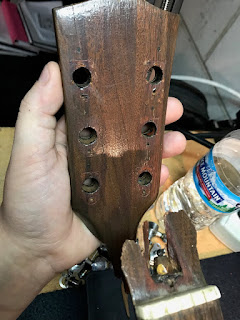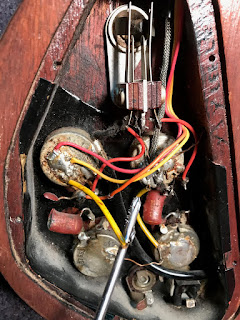First update in a long time. Writing on my blog takes time and I
just haven’t had very much lately. Not to mention I haven’t had any interesting repairs
in a while either. Than this showed up. I was told this was a vintage mid 70s
Gibson SG Standard. The new owner bought it to me in almost this exact condition; the
exception being the headstock that snapped in shipping. Here are just some of
the problems.
· Headstock – see video
· Headcap laminate (aka headstock veneer) removed
· Extra tuner screw holes added for on original
tuners
· Headstock Inlays (or silk screen logo [who
knows]) also removed
· Fingerboard inlays messed up
· Original cherry red sprayed nitro finish was
stripped and redone with brushed on mystery brown finish
· Electronics all kinds of messed up
· Extra second output jack added
· Body fractured by control cavity
· All the extra holes in the top drilled and
filled
· Low E nut slot broken
· Frets (and fret board) look to be in bad shape
too
· Binding around fretboard removed
· Serial number removed from sanding
Knowing this will never again be a collector grade level
instrument I don’t intend on replacing parts and repairing the guitar to be
collector grade, vintage scec; instead I’m going to update much of it with
modern hardware and electronics (keeping the one original pickup). When
everything is said and done, I think this guitar has the potential to be a very
nice, very cool players grade guitar.
The first order of business is to repair the headstock, add a
headcap laminate and see if the repair will even hold a set of strings. From
there I will fix all the other stuff (fretwork, nut, inlays, body crack, ect)
before I do a refin. Lastly a complete makeover of the electronics and a set
up.
The lack of binding and crumby inlays makes me think this was some
sort of SG Special that would have originally had no binding and dot inlays or
small blocks instead of traditional trapezoids. Is it even a real Gibson or a
repro from the “lawsuit” heyday? The guy who sold it to my client said it was
indeed a real Gibson SG standard, but then where’s the fretboard binding, or
was that sanded off too? I don’t think we will ever know. Upon further inspection,
the nut looks to wide, and there is a binding ledge at the bridge end of the
fingerboard. There is also what looks to be binding residue on the edges of the
fingerboard leading me to believe it may have had binding once and it was all
sanded off smooth with the neck.
Who would have done this, and why? So many questions, so few
answers. Like I said, I could take the time to measure the fingerboard width at
the nut and compare it to original Gibson vintage specs, I could try and look
up pot codes, I could try and ID the possibly original pickup, but what’s the
point? The bottom line is I don't think there’s enough original
information here to positively identify the guitar, and even if we could, so
what? It might be nice to see what this guitar
originally had but again, I'm not restoring it to a collector’s grade vintage
pec anyway.










No comments:
Post a Comment